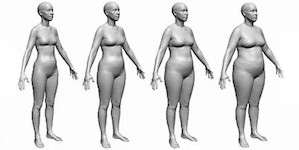Quetelet index

Quetelet index is one of the most common ways to assess body mass index (BMI). It was proposed by Belgian scientist Adolphe Quetelet in 1832.
Calculation of Quetelet index
Quetelet index is calculated using the following formula:
BMI = weight / height2, where
- weight is in kilograms
- height is in centimeters
Normal BMI range
Quetelet index can be used to assess the relationship between a person's weight and height. Depending on the value of BMI, it can be determined whether a person is within the normal range or has overweight or obesity.
Normal Quetelet index values:
- 18.5-24.9 - normal
- 25.0-29.9 - overweight
- ≥ 30 - obesity
Explanations
A BMI of ≥ 18.5 indicates that a person has a normal weight.
A BMI of ≥ 25.0 indicates that a person has overweight. Overweight can lead to the development of such diseases as cardiovascular disease, type 2 diabetes, stroke, some types of cancer.
A BMI of ≥ 30 indicates that a person has obesity. Obesity is a serious condition that can lead to serious complications, such as cardiovascular disease, type 2 diabetes, stroke, some types of cancer, osteoarthritis, sleep apnea.
Limitations of Quetelet index
BMI has a number of limitations. It does not take into account factors such as body fat distribution, muscle mass, age, sex, and ethnicity.
Body fat distribution. BMI does not allow you to determine where fat is deposited in the body. Fat deposited in the abdominal area is more dangerous to health than fat deposited in the hip area.
Muscle mass. People with developed muscles can have a high BMI, but they do not have overweight or obesity.
Age. With age, BMI naturally increases. This is due to the fact that with age, muscle mass decreases and fat mass increases.
Sex. In the normal range, BMI is slightly higher for women than for men. This is due to the fact that women have slightly more body fat than men in the normal range.
Ethnicity. BMI may vary among different ethnic groups.
Comments on the calculator

Calculation of caloric intake depending on weight, height, age, gender and activity using the Mifflin-St. Jeor formula.
Go to calculation
Body Mass Index (BMI) calculator allows assessing the correspondence of a person's body weight to their height.
Go to calculation
Service for converting tons into Russian and British pounds and vice versa. Ton and pounds are units of mass.
Go to calculation